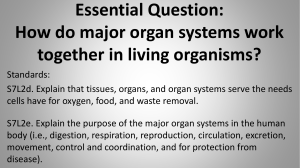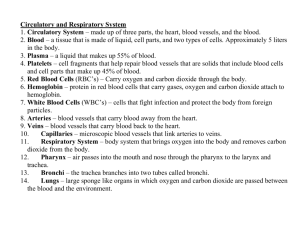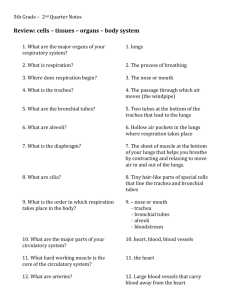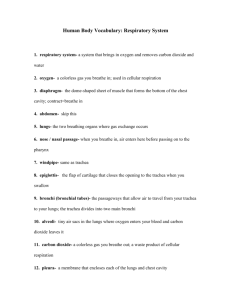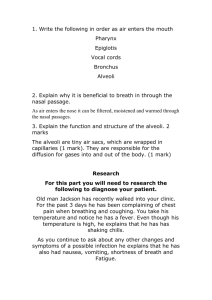Chapter 14- Circulation and Respiration CUE WORDS or
advertisement
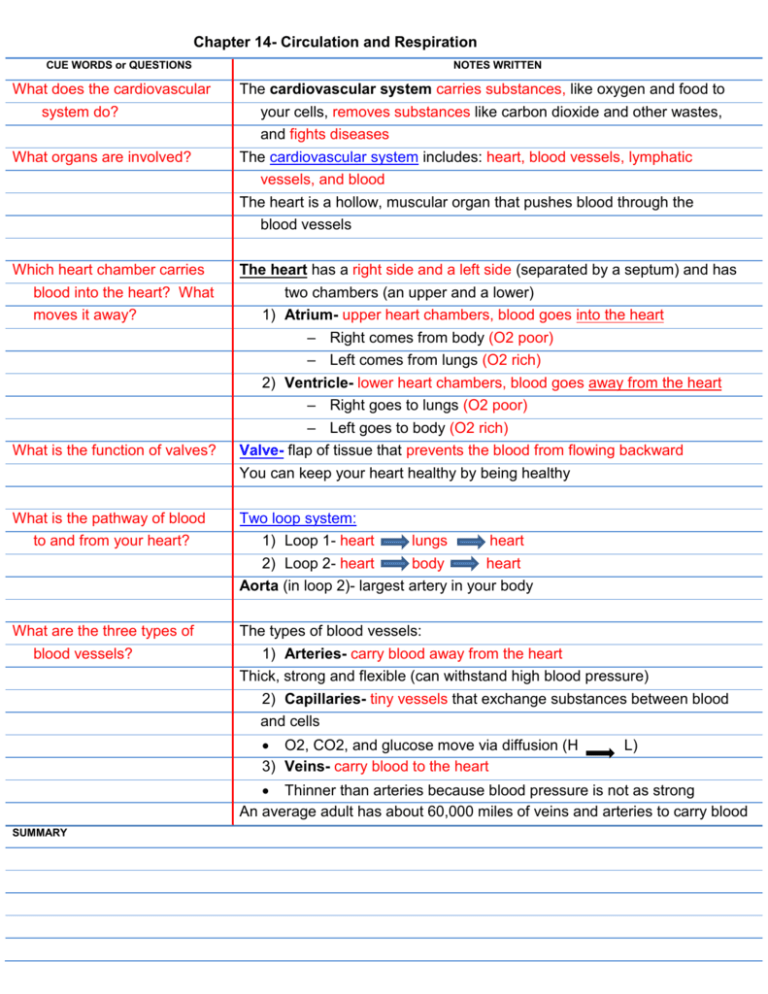
Chapter 14- Circulation and Respiration CUE WORDS or QUESTIONS What does the cardiovascular system do? What organs are involved? Which heart chamber carries blood into the heart? What moves it away? What is the function of valves? What is the pathway of blood to and from your heart? What are the three types of blood vessels? NOTES WRITTEN The cardiovascular system carries substances, like oxygen and food to your cells, removes substances like carbon dioxide and other wastes, and fights diseases The cardiovascular system includes: heart, blood vessels, lymphatic vessels, and blood The heart is a hollow, muscular organ that pushes blood through the blood vessels The heart has a right side and a left side (separated by a septum) and has two chambers (an upper and a lower) 1) Atrium- upper heart chambers, blood goes into the heart – Right comes from body (O2 poor) – – Left comes from lungs (O2 rich) – 2) Ventriclelower heart chambers, blood goes away from the heart – Right goes to lungs (O2 poor) – – Left goes to body (O2 rich) Valve- flap– of tissue that prevents the blood from flowing backward You can keep your heart healthy by being healthy Two loop system: 1) Loop 1- heart lungs heart 2) Loop 2- heart body heart Aorta (in loop 2)- largest artery in your body The types of blood vessels: 1) Arteries- carry blood away from the heart Thick, strong and flexible (can withstand high blood pressure) 2) Capillaries- tiny vessels that exchange substances between blood and cells O2, CO2, and glucose move via diffusion (H 3) Veins- carry blood to the heart L) Thinner than arteries because blood pressure is not as strong An average adult has about 60,000 miles of veins and arteries to carry blood SUMMARY CUE WORDS or QUESTIONS What makes a pulse? What is your blood pressure? What does blood consist of? NOTES WRITTEN Pulse- expansion and relaxation of artery walls as the ventricle contracts, and blood is sent to the body Blood pressure- force against the walls of the blood vessels when heart beats Blood is made of plasma (water, nutrients, and hormones), red blood cells (which carries oxygen and carbon dioxide), white blood cells (which fight diseases), and platelets (which clot blood when you get a cut) What does the respiratory system do? Respiratory system- moves O2 into the body and CO2 out of the body (Cellular respiration- chemical reaction that changes O2 and glucose into energy cellular energy) What is the pathway for air? Pathway for airNose Pharynx Trachea Bronchi Lungs Alveoli Nose – air enters through the nostrils Mucus- sticky liquid that traps dust and bacteria (prevents lining from drying out) Cilia- hair-like cells that move mucus into the throat Pharynx - (throat) connects nose & mouth to trachea Trachea - (wind pipe) lined w/ cilia & moves mucus to pharynx to be swallowed (coughing and sneezing clears the trachea) Bronchi - passage between the trachea & lungs Lung- main organ of the respiratory system Alveoli – tiny sacs of lung tissue that move O2 into blood and CO2 out of blood Capillaries surround alveoli & exchange the gases 300 million alveoli create a surface area of 70 m² What diseases are associated Respiratory disease and illnesses- cold, pneumonia, flu, asthma with your respiratory system? Smoking is one of the worst (and avoidable) things you can do to your health SUMMARY


